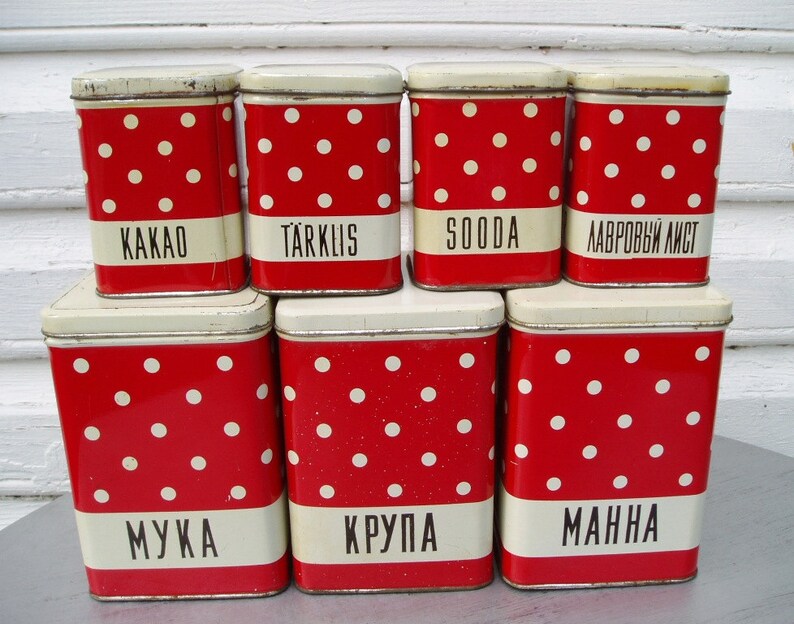Linguaphile wrote:=====
Kas puudel on lehed või koer?
=====
Supi sisse sattunud kokk pidi põgenemiseks kasutama salateid.
=====
Telefonikõne:
- Halloo, kas ma Mona Lisaga saaks rääkida?
- Ei, ta on maal.
These posts are old, I came across them just now while looking for something else. They made me laugh again, and I thought, why not try to translate/explain them? A weird challenge!
Here goes:
Kas puudel on lehed või koer?This one has a double meaning, namely "kas puudel on" can mean either "
do trees have" or "
is a poodle". There's really no way to know which meaning is intended until getting to the end of the sentence. So this pun throws a wrench into that by providing both options in the second half of the question and asking the listener to choose.
So it can mean either (A) or (B), ending with (C).
(A)
Do trees have... (INTEROG tree-PL-ADE be-3s)
(B)
Is a poodle.... (INTEROG poodle-NOM-SING)
(C) .... leaves or a dog? (leaf-NOM-PL or dog-NOM-SING)
Supi sisse sattunud kokk pidi põgenemiseks kasutama salateid.This one is also a pun with a double meaning. This time the two meanings are:
(A)
A cook who has gotten into the soup should use salads in order to escape.(B)
A cook who has gotten into trouble should use secret roads in order to escape.How?
"Supi sisse sattuma" has the literal meaning "to get into the soup" or "to blunder into the soup" but its idiomatic meaning is "to get caught up in a mess," "to get into trouble". And then "salateid" can be the partitive plural of either "salat" ("salad") or "salatee" ("secret road").
So technically there could be four meanings: the two already mentioned above plus
(C)
A cook who has gotten into the soup should use secret roads in order to escape.(D)
A cook who has gotten into trouble should use salads to escape.Those don't make as much sense as (A) or (B). Not that (A) makes all that much sense either, maybe (D) even makes more sense than (A), but at least (A) is clever and has a sort of cartoonish theme about a hapless cook who falls into the broth and enlists the help of vegetables to get back out.
(I hope someday someone makes a cartoon like that. The cook asking for help from the lettuce or the tomatoes and cucumbers and someone else whispering from outside the window: "No, no, no! The roads!" Ei, ei! Teesid! and then the cook could start asking the tea bags for help because that's a whole other pun; teesid is an alternate partitive plural for "tee" meaning "roads", which surely our helpful whisperer would switch to in an attempt be better understood, but is also the partitive plural for the other meaning of "tee", which is "tea"...)Anyway, I think the possibility of (C) and (D) make the pun even funnier. Some part of your brain still has to consider each and every possibility and discard the less possible ones when hearing the joke and it just adds to the weirdness.
Last one:
- Halloo, kas ma Mona Lisaga saaks rääkida?
- Ei, ta on maal.The first line is perfectly normal, I mean, assuming Mona Lisa is a living person in the 21st century (or pre-mobile-phone 20th century) then it's perfectly normal. It's the beginning of a telephone call and it means "Hello, is Mona Lisa there?". Anyone might say this on the phone. But its word-for-word literal meaning is important here: literally it means "Hello, can I speak with Mona Lisa?"
So the answer, "Ei, ta on maal" has (as always) a double meaning.
(A)
No, she's out [in the country]. (no she be-3s country-ADE-SING)
(B)
No, she's a painting. (no she be-3s painting-NOM-SING)
And, I mean... yeah. Either of those is a perfectly good reason for why you can't speak with her right now.
I guess they're probably not quite as funny, or maybe not funny at all, to non-Estonian-speakers who have to rely on the explanations to understand them. Basically, as jokes they're about as untranslatable as you could get since they rely on multiple double meanings. But I think they're quite funny and wanted to try to share them!
 [person on screen, as well as me, thinking: no, that can't be right....] "...Olive oil?"
[person on screen, as well as me, thinking: no, that can't be right....] "...Olive oil?"